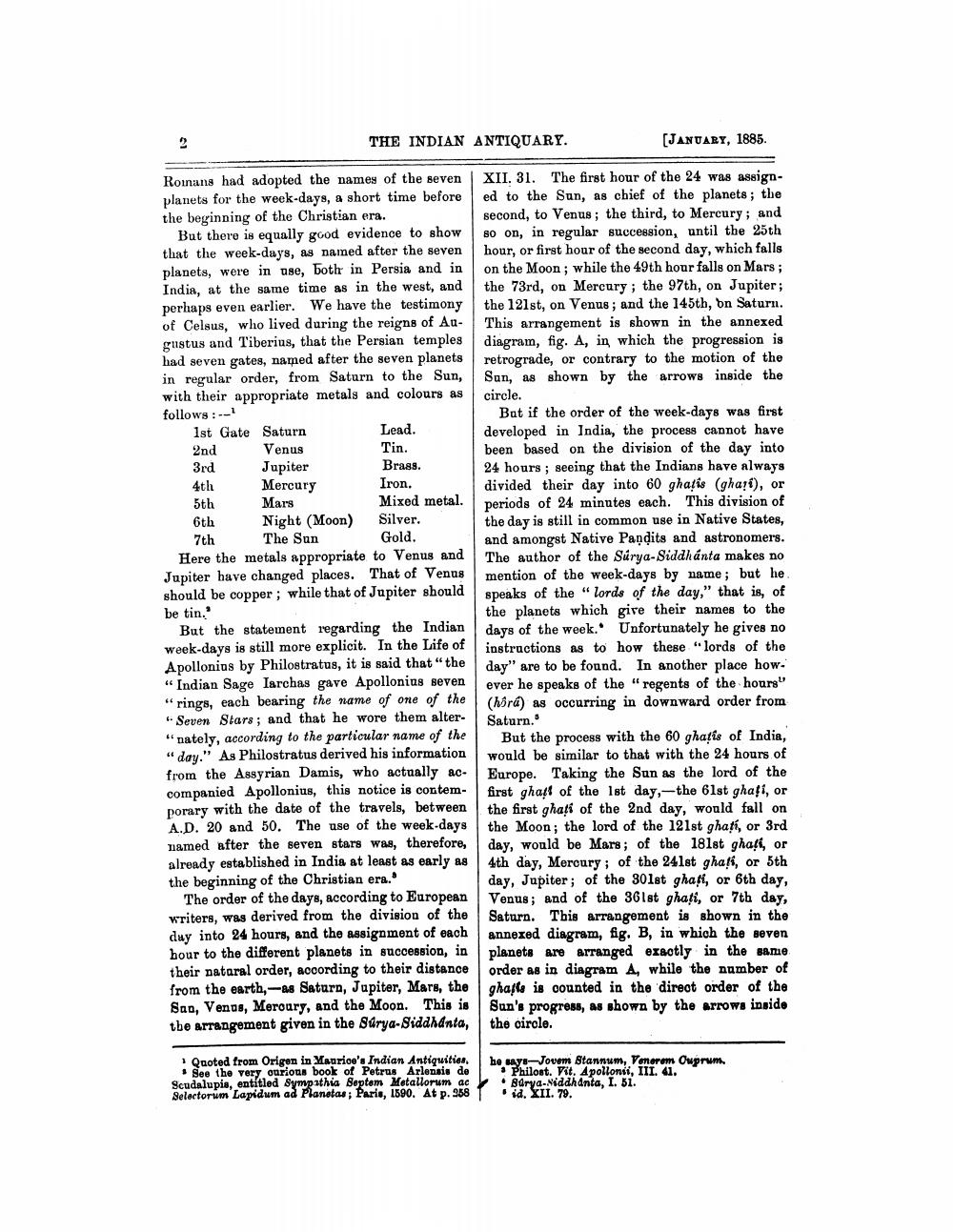Book Title: Indian Antiquary Vol 14 Author(s): John Faithfull Fleet, Richard Carnac Temple Publisher: Swati Publications View full book textPage 8
________________ THE INDIAN ANTIQUARY. (JANUARY, 1885. Brass. Iron. Roinans had adopted the names of the seven planets for the week-days, a short time before the beginning of the Christian era. But there is equally good evidence to show that the week-days, as named after the seven planets, were in use, both in Persia and in India, at the same time as in the west, and perhaps even earlier. We have the testimony of Celsus, who lived during the reigns of Au- gustus and Tiberius, that the Persian temples had seven gates, named after the seven planets in regular order, from Saturn to the Sun, with their appropriate metals and colours as follows:-- 1st Gate Saturn Lead 2nd Venus Tin. 3rd Jupiter 4th Mercury 5th Mars Mixed metal. 6th Night (Moon) Silver. 7th The Sun Gold. Here the metals appropriate to Venus and Jupiter have changed places. That of Venus should be copper; while that of Jupiter should be tin." But the statement regarding the Indian week-days is still more explicit. In the Life of Apollonius by Philostratus, it is said that "the "Indian Sage larchas gave Apollonius seven "rings, each bearing the name of one of the Seven Stars; and that he wore them alter"nately, according to the particular name of the "day." As Philostratus derived his information from the Assyrian Damis, who actually accompanied Apollonius, this notice is contemporary with the date of the travels, between A.D. 20 and 50. The use of the week-days named after the seven stars was, therefore, already established in India at least as early as the beginning of the Christian era." The order of the days, according to European writers, was derived from the division of the duy into 24 hours, and the assignment of each hour to the different planets in succession, in their nataral order, according to their distance from the earth, -as Saturn, Jupiter, Mars, the Sao, Venus, Meroury, and the Moon. This is the arrangement given in the Súrya-Siddhanta, XII. 31. The first hour of the 24 was assigned to the Sun, as chief of the planets; the second, to Venus; the third, to Mercury; and so on, in regular succession, until the 25th hour, or first hour of the second day, which falls on the Moon; while the 49th hour falls on Mars; the 73rd, on Mercury; the 97th, on Jupiter; the 121st, on Venus; and the 145th, on Saturn. This arrangement is shown in the annexed diagram, fig. A, in which the progression is retrograde, or contrary to the motion of the Sun, as shown by the arrows inside the circle. But if the order of the week-days was first developed in India, the process cannot have been based on the division of the day into 24 hours; seeing that the Indians have always divided their day into 60 ghaxis (ghari), or periods of 24 minutes each. This division of the day is still in common use in Native States, and amongst Native Pandits and astronomers. The author of the Súrya-Siddhanta makes no mention of the week-days by name; but he speaks of the " lords of the day," that is, of the planets which give their names to the days of the week. Unfortunately he gives no instructions as to how these "lords of the day" are to be found. In another place however he speaks of the "regents of the hours" (hr) as occurring in downward order from Saturn. But the process with the 60 ghațis of India, would be similar to that with the 24 hours of Europe. Taking the Sun as the lord of the first ghart of the 1st day,—the 61st ghali, or the first ghati of the 2nd day, would fall on the Moon; the lord of the 121st ghatí, or 3rd day, would be Mars; of the 181st ghal, or 4th day, Mercury; of the 241st ghati, or 5th day, Jupiter; of the 301st ghafi, or 6th day, Venus; and of the 36 lst ghati, or 7th day, Saturn. This arrangement is shown in the annexed diagram, fig. B, in which the seven planets are arranged exactly in the same order as in diagram A, while the number of ghafle is counted in the direct order of the Sun's progress, as shown by the arrows inside the circle. Quoted from Origon in Maurioo's Indian Antiquities. • See the very ourious book of Petrus Arlensis de Seudalupis entitled Sympathia Boptom Metallorum ac Selectorum Lapidum ad Planetas; Paris, 1890. At p. 988 T he waysJovem Stannum, Venerem Ouprum. Philost. Tit. Apolloni, III. 41. • drva.Niddhanta, I. 51. i d EIL. 79Page Navigation
1 ... 6 7 8 9 10 11 12 13 14 15 16 17 18 19 20 21 22 23 24 25 26 27 28 29 30 31 32 33 34 35 36 37 38 39 40 41 42 43 44 45 46 47 48 49 50 51 52 53 54 55 56 57 58 59 60 61 62 63 64 65 66 67 68 69 70 71 72 73 74 75 76 77 78 79 80 81 82 ... 418
